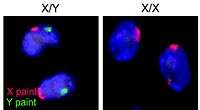Virilization
| Part of a series on |
| Sex |
|---|
 |
| Biological terms |
| Sexual reproduction |
| Sexuality |
|
Virilization or masculinization is the biological development of sex differences, changes that make a male body different from a female body. Most of the changes of virilization are produced by androgens. Virilization is most commonly used in three medical and biology of gender contexts: prenatal sexual differentiation, the postnatal changes of normal male puberty, and excessive androgen effects in girls or women.
Prenatal virilization
In the prenatal period, virilization refers to closure of the perineum, thinning and wrinkling (rugation) of the scrotum, growth of the phallus, and closure of the urethral groove to the tip of the penis. In this context, masculinization is synonymous with virilization.
Prenatal virilization of genetic females and undervirilization of genetic males are common causes of ambiguous genitalia and intersex conditions.
High
Prenatal virilization of a genetically female fetus can occur when an excessive amount of androgen is produced by the fetal adrenal glands or is present in maternal blood. In the severest form of congenital adrenal hyperplasia, complete masculinization of a genetically female fetus results in an apparently normal baby boy with no palpable testes. More often, the virilization is partial and the genitalia are ambiguous.
It can also be associated with progestin-induced virilisation.
Low
Undervirilization can occur if a genetic male cannot produce enough androgen or the body tissues cannot respond to it. Extreme undervirilization occurs when no significant androgen hormones can be produced or the body is completely insensitive to androgens. Both result in a female body. Partial undervirilization produces ambiguous genitalia part-way between male and female. The mildest degree of undervirilization may be a slightly small penis. Examples of undervirilization are androgen insensitivity syndrome, 5 alpha reductase deficiency, and some forms of congenital adrenal hyperplasia.
Normal virilization
In common as well as medical usage, virilization often refers to the process of normal male puberty, in which testosterone changes a boy's body into a man's. These effects include growth of the penis and testes, accelerated growth, development of pubic hair, and other androgenic hair of face, torso, and limbs, deepening of the voice, increased musculature, thickening of the jaw, prominence of the neck cartilage, and broadening of the shoulders.
Abnormal childhood virilization
Virilization can occur in childhood in either boys or girls due to excessive amounts of androgens. Typical effects of virilization in children are pubic hair, accelerated growth and bone maturation, increased muscle strength, acne, and adult body odor. In a boy, virilization may signal precocious puberty, while congenital adrenal hyperplasia and androgen producing tumors (usually) of the gonads or adrenals are occasional causes in both sexes.
In adolescent or adult women
Virilization in a woman can manifest as clitoral enlargement, increased muscle strength, acne, hirsutism, frontal hair thinning, deepening of the voice, and menstrual disruption due to anovulation.[1] Some of the possible causes of virilization in women are:
- Androgen-producing tumors of the
- Polycystic ovary syndrome
- Hyperthecosis
- Hypothyroidism
- Anabolic steroid exposure
- Congenital adrenal hyperplasia due to 21-hydroxylase deficiency (late-onset)
- Conn's syndrome
Medically induced virilization in transgender people
Transgender people who were medically assigned female at birth (typically trans men, but also people with other non-female gender identities) sometimes elect to take hormone replacement therapy. This process causes virilization by inducing many of the effects of a typically male puberty. Many of these effects are permanent, but some effects can be reversed if the transgender individual stops or pauses their medical treatment.
Permanent virilization effects
- Deepening of the voice
- Growth of facial and body hair
- Male-pattern baldness
- Enlargement of the clitoris
- Breast atrophy – possible shrinking and/or softening of breasts
Reversible virilization effects
- Further muscle development (especially upper body)
- Increased sweat and changes in body odor
- Prominence of veins and coarser skin
- Alterations in blood lipids (cholesterol and triglycerides)
- Increased red blood cell count
See also
- Ambiguous genitalia
- Androgen
- Clitoromegaly
- Feminization (biology)
- Hirsutism
- Secondary sex characteristics
- Sexual differentiation
References
External links
| Look up virilization in Wiktionary, the free dictionary. |